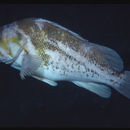en
names in breadcrumbs


No information was available on communication in this species.
Perception Channels: visual ; tactile ; chemical
Copper rockfish are not yet theatened, however other rockfish species are endangered. Rockfish are a valuable game fish and it is important for precautions to be implemented to prevent overfishing. This is especially important with rockfish populations since the fish have long lifespans with their reproductive capacity increasing as they age.
US Federal List: no special status
CITES: no special status
Copper rockfish are live-bearers and in California waters, the larvae are released in the spring when they are 5-6 mm in length. Generally among rockfish, the larvae drift in offshore waters and survive in the upper 80 m of the water column for 1-2 months before they transform into juveniles. Because of identification problems with other species of rockfish, the distribution of copper rockfish larvae and juveniles are often debated. In central California, these juveniles are closely associated with the surface and mid-depth kelp beds and do not become benthic until they have reached 40-50 mm.
Growth rates are fastest in fish less than 3 years old and are highest in the summer months, coinciding with high feeding rates and upwelling. Sexual maturity has been shown to vary slightly between different regions along the Pacific coast. Off central California, males become sexually mature between the ages of 3 and 7 years. Females are fully mature by 8 years. These fish often reach 20 years of age.
Development - Life Cycle: metamorphosis
Copper rockfish have no known negative impacts on humans.
The copper rockfish, as well as other rockfish species that live in the California coastal waters, are very important to commercial and sport fisheries. The 60 species of rockfish caught account for 34% by weight of all sportfish landed in California.
Positive Impacts: food
At all life stages, copper rockfish are eaten by other fish. They also eat different types of fish and marine invertebrates.
Copper rockfish are opportunistic carnivores that feed mainly on organisms present near the ocean floor, usually crabs, mollusks and other fish. They feed during the day as well as at night. Often the prey varies with the season with crabs eaten more often in winter and early spring. Large copper rockfish tend to be aggressive feeders and sometimes prey on Squalus acanthias, a small shark species.
Animal Foods: fish; mollusks; aquatic or marine worms; aquatic crustaceans
Primary Diet: carnivore (Piscivore , Eats non-insect arthropods)
Copper rockfish are found in waters along the Pacific coast ranging from Baja, California up to Kehui, Alaska. They are common in the waters of British Columbia and in Puget Sound.
Biogeographic Regions: pacific ocean (Native )
Copper rockfish are demersal, preferring the ocean bottom near low-profile rocks and reefs. The range of water depths they inhabit is relatively broad, from 10 to 183 meters, and the fish are found in shallower water during upwelling. Most often, these fish are in close contact with reefs, maintaining an even closer contact during the winter and spring than in the summer months. Tagging experiments have suggested that mature fish do not move far from their home location.
Range depth: 10 to 183 m.
Habitat Regions: saltwater or marine
Aquatic Biomes: benthic ; reef
Copper rockfish can live to be decades old and take several years to become sexually mature. Once mature, females generally produce a higher number of eggs each year. These traits are important for the survival of the species since a relatively low percentage of young survive each year. Few if any efforts have been made to breed copper rockfish in captivity.
Range lifespan
Status: wild: 55 (high) years.
Typical lifespan
Status: wild: 40 (high) years.
Average lifespan
Status: captivity: 55 years.
Their overall color is variable but a copper-brown color with darker fins is generally observed. Patches of yellow or copper are also present, usually near the gill coverings. They are distinguished from other rockfish species by the clear areas along the posterior two thirds of the lateral lines, and in having a whitish underside. They have 13 dorsal and 3 anal spines that are mildly venomous.
Range mass: 2.6 (high) kg.
Range length: 57 (high) cm.
Other Physical Features: bilateral symmetry
Juvenile rockfish that reside in kelp beds are often eaten by many fishes and other marine animals. Adults are eaten by lingcod Ophiodon elongatus and also other large predators.
Known Predators:
No information could be obtained describing the mating behaviors of copper rockfish or any of the various rockfish species.
Spawning in copper rockfish occurs once a year in the spring at a time that varies geographically. Fertilization occurs internally, and little is known about the specific courtship or mating behaviors. Females move inshore to release their young and are capable of regulating where and when larvae are released. This is thought to be dependant on environmental conditions. As is true of other rockfish species, fecundity is related to length.
Breeding interval: Spawning occurs once a year.
Breeding season: Spawning occurs most often during early spring but varies among different geographies.
Range number of offspring: 100,000 larvae to 300,000 larvae.
Range age at sexual or reproductive maturity (female): 8 (high) years.
Range age at sexual or reproductive maturity (male): 3 to 7 years.
Key Reproductive Features: seasonal breeding ; gonochoric/gonochoristic/dioecious (sexes separate); sexual ; fertilization (Internal ); ovoviviparous
Copper rockfish larvae are independent once they are released inshore. The female provides internal nourishment to the embryos until they are released.
Parental Investment: pre-hatching/birth (Provisioning: Female)